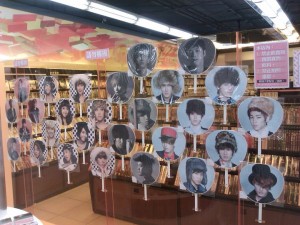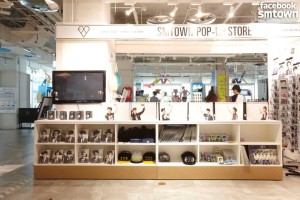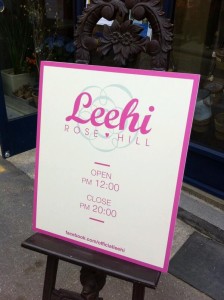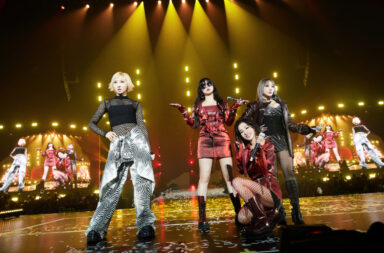 For many international fans, walking into a store and seeing a mass of K-pop merchandise is a distant dream. If they want posters, physical albums, folders, and other memorabilia, they must flock to the internet to do their shopping. But, imagine a K-pop emporium where all of the posters and pillowcases adorned with your favorite Korean idol’s dazzling face await you. Everything you want as a fan, if you’re willing to pay, is accessible at that very moment. This is exactly the experience K-pop companies are bringing to fans via pop-up stores.
For many international fans, walking into a store and seeing a mass of K-pop merchandise is a distant dream. If they want posters, physical albums, folders, and other memorabilia, they must flock to the internet to do their shopping. But, imagine a K-pop emporium where all of the posters and pillowcases adorned with your favorite Korean idol’s dazzling face await you. Everything you want as a fan, if you’re willing to pay, is accessible at that very moment. This is exactly the experience K-pop companies are bringing to fans via pop-up stores.
Pop-up stores predate the K-pop industry, but only within the last few years have they taken new and innovative form during the digital age. What began more than a decade ago as a method for providing seasonal products during certain parts of the year has transformed into an ever-changing business model used to spark publicity, test popularity, and ultimately make quick money for a company at lower costs.
The online business journal of The Wharton School of the University of Pennsylvania sums up the pop-up store model in these words:
…a retailer looking to sell something with a short shelf life, launch a brand or build awareness opens a storefront for a few days or weeks. Displays are put up, product is stocked, business is conducted and buzz created — and then it’s gone.
The key of the pop-up store is the time limit. By showcasing special products for a brief period of time, the desire for fans to look at and buy these products increase. And, in the case of Korean entertainment companies, these showcases are elegantly timed to the debuts and comebacks of K-pop acts, all to maximize customer traffic to purchase their items.
SM Entertainment is known for its skill in branding its artists, and the company took a huge leap forward in this effort in January with the opening of an SM Town pop-up store in Myeongdong, a large shopping district and tourist attraction in Seoul. Taking up only half of one floor in the Lotte Young Department Store, the shop is filled with products from SM Town artists. From the typical (posters and albums), to the fashion-forward (caps and sweatshirts), to the quirky (idol stamp pads and pillowcases), there’s more than enough in the store to satisfy both the casual and the devoted fans.

The layout is simple: open space with bulky desks and shelves loaded with merchandise, but the store still attracts hundreds of fans in a day, suggesting that expenses to run the place are kept low while profit only increases. Its placement in Myeongdong, complete with a large billboard featuring the current promoting artist, is hard to miss on the street.
The SM model of pop-up stores serves as a simplistic storefront example of what pop-up stores can do for K-pop shoppers, but what happens when companies get more creative? Earlier this year, 2NE1 partnered with Chrome Hearts, a popular jewelry brand, to create custom pieces inspired by the members. To promote the designs and build up buzz for 2NE1’s comeback later in the year, the company set up shop in the Shinsegae Department Store for one month.
The jewelry was sold there for the promotional period, and was subsequently released worldwide afterwards. To top it off, the members made an appearance at the store to meet fans and hold a quick talk, making the short-lived store an extremely special experience for shoppers.
The 2NE1 pop-up shop’s clear strength is its innovation – choosing one product to highlight and then building the group around it, instead of the SM model of stamping every SM Town idol’s face on any flat surface they can find (although the Yunho coffee mug was quite tempting).
[youtube http://www.youtube.com/watch?v=STqQjRyGVKQ]And unlike the SM Town pop-up store, which has been indefinitely running in Myeongdong for more than six months now, the Chrome Hearts shop had a clear start and end date, giving fans a sense of urgency to travel to the pop-up store to get their 2NE1 fix and possibly purchase a special piece of jewelry as well. By partnering with a specific business, 2NE1 succeeded in creating a more unique product than the standard poster and album combo.
Also making a strong statement in the K-pop pop-up store trend is Lee Hi’s pop-up store for her debut album, First Love, and accompanying single “Rose.” One can imagine that setting up this type of shop for a new artist is tougher task.
Since the public is just starting to get to know the artist and the new music, attracting customers beyond just the devoted fans requires not only great planning, but a unique idea. YG Entertainment managed to do just that with the Rosehill pop-up store held for Lee Hi at London Flower and Garden, another store in Shinsegae.
The Rosehill store took both the rose concept and the temporary concept quite literally: visitors received ribbon-adorned roses and had the chance to win free concert tickets, and the store was only open for one day.

Trendy, cute, and charming, Lee Hi’s pop-up store finishes first for the best customer experience. It had a clear theme, and, by making such a fleeting appearance, it seemed fresh and interesting to fans. The pop-up store wasn’t created just to sell her album; it advanced her concept and certainly caught the attention of passers-by.
Pop-up stores have made it easy to create a K-pop themed shopping experience that doesn’t have to exist online. And more importantly, the opportunities for companies to get creative in satisfying the interests of fans is endless. Photo and video teasers are great and all, but with pop-up stores, fans get to both participate in the fandom of their favorite artist while making their K-pop purchases at the same time.
So what do you think, readers? Would you prefer a shop where you can buy anything and everything of your favorite groups or a more low-key place with a unique concept? Also, what kind of items would you want to be sold in a K-pop pop-up store?
(Facebook [1][2], Twitter, SM Entertainment, YG Entertainment, YouTube)


